

One of the exciting projects I have been fortunate to be a part of was the discovery of fossil melanin and developing methods to put colors on fossils, such as for example feathered dinosaurs. The study has made a significant impact with respect to how we can perceive fossil feathered dinosaurs – we can now reconstruct them with their original color patterns!
My collaborators on these projects are Derek Briggs, Matthew Shawkey, Julia Clarke, Richard Prum, Liliana D`Alba, Li Quanguo, Gao Keqin, Gerald Mayr.
A dedicated essay editor was called in to polish the end result.
National Geographic and NSF has funded these projects
Squid Fossils History
It all started in the fall of 2006. I was in my first year of graduate studies when I did a project on exceptionally preserved squids and their ink sacs. My question was mainly to figure out why the ink sac is preserved in three dimensions while the rest is completely squashed, even the shell. I began this task as one should approach it as a student of Derek Briggs, by decaying a bunch of squids.
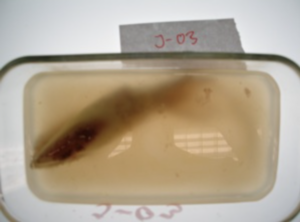
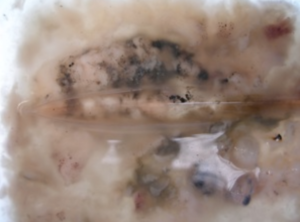
However, After a few days (picture right), everything had dissolved into a sludge. the stench is not even possible to describe without loosing the ability to eat calamari for a year. Not much came out of these experiments, the squids rotted away, and the ink sac dissappeared too. So I could only conclude that it is truly exceptional when you find a fossil softbodied squid.
While the decay experiments failed miserably, my studies of the fossil ink sacs lend insights to a great idea. The fossil ink sacs were preserved as solid organic blobs. When looking at these organic blobs, one could see that they were composed of the melanin from the ink preserved at microscopic level.
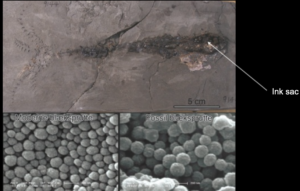
As the picture shows above, the fossil ink (lower right) is identical to modern squid ink (lower left). The fact that the ink was preserved has been known for some years, but this made me think that there must be fossil melanin elsewhere. I could make that assertion because melanin is chemically the same in all animals and if it preserved so well here, it must be preserved in other organisms and if so, we might be able to put colors on a fossil feather on perhaps a dinosaur.
My first attempts to test this hypothesis were done back home in Denmark on a Christmas trip in 2007. We have a fossil scull of a bird with a halo of feathers in it and I managed to get the preparator to cut down the block to a size so that I could get it in the SEM at the museum. When I zoomed in I was met by an ocean of little sausages. Exactly how the melanin is contained in bird feathers as well as in mammal hair, within the melanosomes.
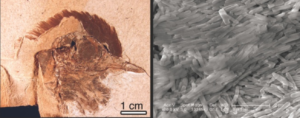
I showed these to Derek, who noted that these structures has been identified as bacteria and he found an additional good candidate to prove the concept that these structures are melanosomes and not bacteria with a Cretaceous (~100 ma) fossil feather from Brazil (Crato FM) preserved with color patterns.
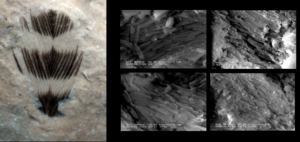
The fossil clearly showed the presence of melanosomes in the dark bands and not in the light bands as would be expected if the structures were color-imparting melanosomes.
Subsequently we continued our studies to the well preserved feathers from Messel in Germany, Middle Eocene (47 ma). There we found and described a feather with structural coloration.


More recently we have developed methods to empirically predict colors by measuring the shape and distribution of melanosomes and analysing them statistically with modern feathers. This has culminated with the description of plumage color patterns of one of the oldest know feathered dinosaurs, Anchiornis huxleyi, and a giant Eocene penguin, Incayacu paracaensis.



Liliana and Matt holding the Microraptor specimen that recently was studied (Li et al. 2012), photo credit: Li Quanguo.